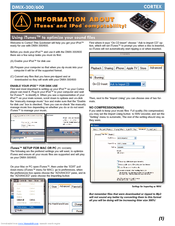Cortex Dmix 600 Software Update
Cortex DMIX-600 Product Manual 142 pages. DJ Equipment Cortex DMIX-300 Product Manual. It is advisable that the unit is not moved during the update process to.
In the meantime, laptop performance has fought its way to respectability in the DJ world, but DJing from an iPod (and other hard-drive devices) still has some work ahead of it to be taken seriously. More than a year ago, after an initial wave of iPod mixing products were largely written off as toys, a new breed will hatch this year to take iPod DJing into the realm of legitimacy.
I've always found that MClass is on a par if not better than L2. Lowlifebware wrote:I tend to use the MClass as a 2nd choice because I now use Ozone Maximiser. I've Mastered countless songs and projects with it. Always used them.  However the MClass will always to a decent job Keep in mind too that the L2, despite its high quality, is getting pretty long in the tooth now, so it shouldn't just be thought of as 'it's really expensive, so it must be better'.
However the MClass will always to a decent job Keep in mind too that the L2, despite its high quality, is getting pretty long in the tooth now, so it shouldn't just be thought of as 'it's really expensive, so it must be better'.
A key component to those pieces, including the new Cortex dMIX-300, is the streaming technology necessary to play two songs at once from a single iPod, change the pitch of those songs and digitally scratch them — all traits the earlier iPod mixers didn't share. DECK, DOCK, DECK There's no mystery to the dMIX-300's all-in-one physical layout.

A full 2-channel mixer centers the unit, with two identical deck sections on each side for controlling music playback. A built-in iPod dock accommodates any iPod model with a dock connector — iPod 3G and later, iPod Mini and iPod Nano — and adapter plates for the Mini and Nano models are included. A single USB 2 Type-A port on the back panel labeled MSD (mass storage device) connects USB drives; you can also connect a powered USB hub to hook up a maximum of four USB storage devices at a time feeding into that one port. As a bridge to the physical world, the dMIX-300 has two stereo audio inputs on unbalanced RCA connectors on its back panel.
You can switch the inputs from phono to line-level to hook up a total of two turntables (grounding included) and/or CD players. At the top of each mixer channel strip is a switch to select either the MSD USB port or the analog input as the source for that channel.
The mixer also has a gain knob, 3-band EQ (with center detents), a 60 mm volume fader and blue-lit volume meter for each channel. A removable crossfader features a 2-curve switch to change from a smooth fade for blending or a quick-cut curve for scratching. Two separate ¼-inch TS mic inputs — one on the front and one on the back panel — can be active simultaneously for dynamic mics or other mics that don't need phantom power.
Both mic inputs share a mic volume knob and low- and high-EQ knobs on the front panel. The mic signals flow equally to each of the three stereo outputs on the back: master, booth and record, which all exist on a pair of unbalanced RCA connectors.
Both the master and booth outputs have corresponding level attenuators in the mixer, while the record output has no volume control but is set to a consistent -10 dB level. Finally, there is a headphone cue section in front with a ¼-inch stereo phones jack, volume control and a cue fader that blends the headphone mix between Cue 1 (left channel) and Cue 2 (right channel). Each channel deck includes a 20-by-4-character, blue backlit LCD with contrast control located inside the menus. Info, Play and Search buttons, as well as a set of arrow keys, help to navigate song databases, search for tracks and play them. Pitch-control “±” buttons and a slider can be turned to alter pitch at a selectable range of ±4, 8, 16 or 24 percent.